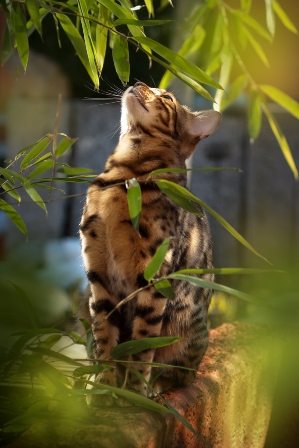Cat and the Plants – Poisonous and Favourite One
Cat and the Plants – Poisonous and Favourite One
Is it possible for your plants and cat to live in harmony with each other and share the same place? Maybe this question is not very important if you have an outdoor cat, but for indoor cats it is of a great importance. As your apartment represents the whole world for the indoor cat, and the cats are well known for their curiosity, sometimes it could appear as impossible for these two to coexist happily. Many plants showed as toxic for cats, and if you want to provide the safer surrounding for the cats, you can ensure that any of your plants are not in the following list. The article “Poisonous Plants for Cats” lists the most common toxic plants.
Cat and the Plants – Poisonous and Favourite One
• Amaryllis (Amaryllis sp.)
• Autumn Crocus (Colchicum autumnale)
• Azaleas and Rhododendrons (Rhododendron sp.)
• Castor Bean (Ricinus communis)
• Chrysanthemum (Chrysanthemum sp.)
• Cyclamen (Cyclamen sp.)
• English Ivy (Hedera helix)
• Kalanchoe (Kalanchoe sp.)
• Lilies (Lilium sp.)
• Marijuana (Cannabis sativa)
• Oleander (Nerium oleander)
• Peace Lily (Spathiphyllum sp.)
• Pothos (Epipremnum aureum)
• Sago Palm (Cycas revoluta)
• Spanish thyme (Coleus ampoinicus)
• Tulip and Narcissus bulbs (Tulipa and Narcissus sp.)
• Yew (Taxus sp.)
If you want to make your place friendly for the cat, the article “6 Plants Your Cat Will Love” offers the list of plants in which your cat will probably enjoy:
1. Cat Grass (dactylis glomerata)- this is an obvious one, but why spend $4 – $6 a pop at the store when you can grow it yourself? Great not only for cats to help with digestions, but for dogs, guinea pigs and bunnies, too.
2. Lemongrass (cymbopagon) – Kitties love the smell of lemongrass, so if you’re growing some for yourself, grow some extra for them to gnaw on.
3. Catnip (nepeta cataria) – As seen in the photo below, some kitties will go absolutely crazy for this stuff. Caution: it will also attract neighborhood cats. So if you don’t want it all steamrolled by chemically altered felines, you might want to grow some of it in a hanging basket. I learned this the hard way when I found all the catnip in my garden completely flattened. At least some kitties had a good time!
4. Catmint (nepeta x faassenii) – Gorgeous plant with purple blooms, attracts not only cats, but butterflies and bees, as well!
5. Mint family – Cats can be attracted to mint, while mice are deterred by peppermint. So, if you want to make your furry friends happy and lessen your chance of having a mousy gift left on your front doorstep, peppermint might be just the ticket.
6. Valerian (valeriana officinalis, valerianaceae) – Has a similar effect as catnip and is a mild stimulant. Commonly has white or pink flowers.
Anyway, some plants can be dangerous for your cat and whether the cat is an indoor or outdoor one, it is necessary to be aware of the symptoms that may imply your cat has been poisoned by plants. Any irregularity you noticed, like breathing problems, difficulties with swallowing the food, vomiting, diarrhea, excessive drinking and urinating, can be warning signs that alarm you to take immediate action and call the vet. Thus, free your space from the most poisonous plants and divert the cat’s attention from other plants to its favorites. In order to distract the cat from the plants you want, you can sprinkle citrus peels on the soil or any nasty-tasting substance from your pet shop, or simply by using Tabasco sauce. Divert the cat’s attention from the potential problematic plants, get rid of the most poisonous plants that could be fatal for the cat and provide your pet with the safe plants it likes, if you want to share your space with the cat and plants safely and enjoy it.










